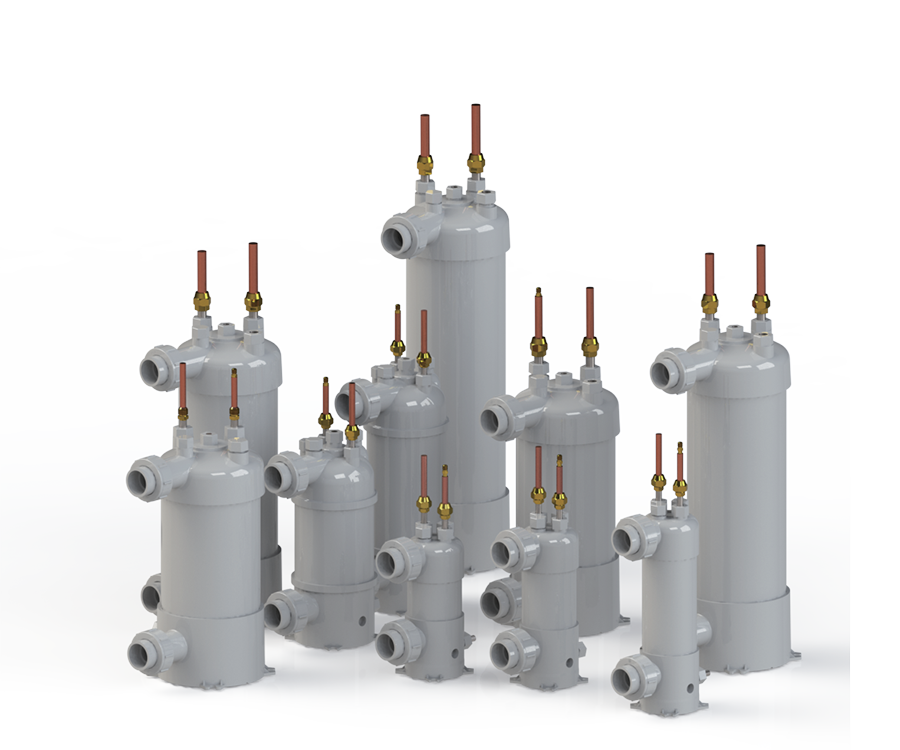- Menu
- Search For Product Models
Search For Product Models
- cn

Titanium tube heat exchanger with a PVC shell is commonly used in swimming pool heat pumps, functioning either as an evaporator or a condenser. This configuration leverages the corrosion resistance of titanium and the durability of PVC, making it suitable for the chemically treated water in pools.
Evaporator:
Refrigerant Side: Low-pressure refrigerant enters the titanium tubes and absorbs heat from the pool water, causing it to evaporate.
Water Side: Pool water circulates through the PVC shell, transferring heat to the refrigerant, resulting in cooled water returning to the pool.
Condenser :
Refrigerant Side: High-pressure refrigerant gas enters the titanium tubes and releases heat, condensing into a liquid.
Water Side: Cooler pool water in the PVC shell absorbs the heat from the refriger- ant, warming the water before it returns to the pool.
Advantages:
• Corrosion Resistance: Titanium's resistance to corrosion ensures longevity, even with exposure to chlorinated or saltwater pools.
• Durability: The combination of titanium and PVC provides a robust structure capable of withstanding pool environments.
• Efficiency: The design facilitates effective heat transfer, enhancing the performance of the heat pump.

We provide a comprehensive range of compact PVX Ti tube heat exchanger to endure the demanding conditions.
 High Heat Transfer Efficiency
High Heat Transfer EfficiencyTitanium’s thermal conductivity ensures effective heat transfer between fluids , further boosted by fluted or rifled tube designs.
 Environmental Benefits
Environmental BenefitsTitanium and PVC are recyclable, promoting eco-friendliness. PVC’s low thermal conductivity minimizes heat loss, boosting efficiency.
 Exceptional Corrosion Resistance
Exceptional Corrosion ResistanceTitanium resists corrosion from chemicals, chlorine, and saltwater, while PVC withstands pool chemicals and acidic conditions, ensuring durability.
 Low Maintenance Requirements
Low Maintenance RequirementsTitanium and PVC resist fouling and scaling, reducing cleaning needs and maintenance costs while remaining easy to maintain.
 Lightweight
LightweightTitanium's strength and lightness reduce heat exchanger weight without sacrificing durability, while PVC offers a sturdy, easy-to-install shell.
 Safety and Non-Toxicity
Safety and Non-ToxicityBoth titanium and PVC are non-toxic materials, ensuring safety for applications involving drinking water, swimming pools, and food-grade processes.
TEMPERATURE RANGE
TI tube side ——FROM -50°C (-58°F) TO 150°C (302°F)
PVC shell side ——FROM -10°C (14 °F) TO 35°C (95 °F)
PRESSURE RANGE
TI tube side ——Max 45 BAR
PVC shell side ——Max 5 BAR
MEDIA IN SHELL
- Swimming pool water Salt water
- Plating Solutions
- Ethylene Glycol & Propylene Glycol
MEDIA IN TUBES
-R22 、R134a 、R404a 、R407c 、 R410a 、R417a 、R600a 、etc.


Model |
Capacity |
Waterflow |
A |
B |
C |
D |
Tube OD |
Tube length |
PVX-38 |
3.8 |
1.8 |
80 |
250 |
310 |
φ 110 |
12.7 |
3 |
PVX-45 |
4.5 |
2 |
80 |
290 |
350 |
φ 110 |
12.7 |
4.9 |
PVX-95 |
9.5 |
4.2 |
80 |
370 |
430 |
φ 110 |
12.7 |
6.5 |
PVX-120 |
12 |
5.5 |
80 |
365 |
430 |
φ 160 |
12.7 |
8.4 |
PVX-140 |
14 |
6.2 |
80 |
445 |
510 |
φ 160 |
12.7 |
10.5 |
PVX-170 |
17 |
7.5 |
80 |
440 |
510 |
φ 200 |
16 |
9.8 |
PVX-210 |
21 |
9.2 |
80 |
460 |
530 |
φ 200 |
19 |
10 |
PVX-250 |
25 |
12 |
80 |
550 |
620 |
φ 200 |
19 |
12.5 |
PVX-300 |
30 |
14 |
80 |
630 |
700 |
φ 200 |
19 |
15 |
PVX-360 |
36 |
15 |
80 |
710 |
780 |
φ 200 |
19 |
17 |

